

Bakeneko. "The Bakeneko of the Sasakibara Family" (榊原家の化け猫) from the Buson Yōkai Emaki by Yosa Buson.

It depicts a cat in Nagoya that would wear a napkin on its head and dance. In this book, it states that "every night, nekomata (猫また) would go out and dance," and unlike the nekomata which has two tails, this cat has only one tail.[1] The bakeneko (化け猫, "changed cat") is a type of Japanese yōkai, or supernatural creature. According to its name, it is a cat that has changed into a yōkai. Bastet. Photograph of an alabaster cosmetic jar topped with a lioness, representing Bast, an 18th dynasty burial artifact from the tomb of Tutankhamun circa 1323 BC - Cairo Museum Bastet was a goddess in ancient Egyptian religion, worshipped as early as the Second Dynasty (2890 BC).
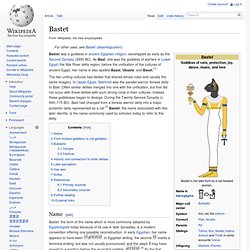
As Bast, she was the goddess of warfare in Lower Egypt, the Nile River delta region, before the unification of the cultures of ancient Egypt. Her name is also spelled Baast, Ubaste, and Baset.[1] The two uniting cultures had deities that shared similar roles and usually the same imagery. In Upper Egypt, Sekhmet was the parallel warrior lioness deity to Bast. Beast of Bodmin. The Beast of Bodmin, also known as the Beast of Bodmin Moor[1] (Cornish: Best Goon Brenn) is a phantom wild cat purported to live in Cornwall, England, United Kingdom.
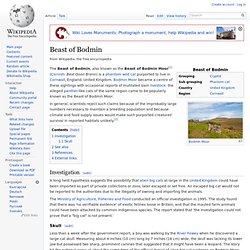
Bodmin Moor became a centre of these sightings with occasional reports of mutilated slain livestock: the alleged panther-like cats of the same region came to be popularly known as the Beast of Bodmin Moor. In general, scientists reject such claims because of the improbably large numbers necessary to maintain a breeding population and because climate and food supply issues would make such purported creatures' survival in reported habitats unlikely.[2] Investigation[edit] A long held hypothesis suggests the possibility that alien big cats at large in the United Kingdom could have been imported as part of private collections or zoos, later escaped or set free.
An escaped big cat would not be reported to the authorities due to the illegality of owning and importing the animals. Blue Mountains panther. Cactus cat. The cactus cat is a mythical fearsome critter of the American Southwest.
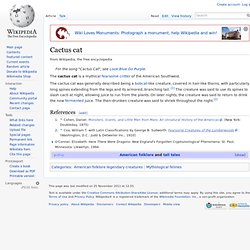
O'Conner, Elizabeth. Here There Were Dragons: New England's Forgotten Cryptozoological Phenomena. St. Cat sìth. The Cat Sìth (Scottish Gaelic: [kʰaht̪ ˈʃiː]) or Cat Sidhe (Irish: [kat̪ˠ ˈʃiː], Cat Sí in new orthography) is a fairy creature from Celtic mythology, said to resemble a large black cat with a white spot on its breast.

Legend has it that the spectral cat haunts the Scottish Highlands. The legends surrounding this creature are more common in Scottish folklore, but a few occur in Irish. Demon Cat. Demon Cat (or D.C.)[1] is the name given to the ghost of a cat which is purported to haunt the government buildings of Washington, D.C..

The story of the Demon Cat dates back to the days when cats were brought into the basement tunnels of the Capitol buildings to kill rats. Legend states that the Demon Cat is one who never left.[2] Its home is supposedly the basement crypt of the Capitol which was originally intended as a burial chamber for President George Washington.[3] According to legend, the cat is seen before presidential elections and tragedies in Washington DC,[4] allegedly being spotted by White House security guards the nights before the assassinations of John F. Kennedy and Abraham Lincoln.[5] The cat is described as fully black and the size of an average house cat;[6] but witnesses report that the cat swells to "the size of a giant tiger",[1] 10 feet by 10 feet,[7] when alerted. Explanation[edit] Ennedi tiger. The Ennedi tiger is a purportedly living Sabertooth cat inhabiting the Ennedi Plateau, located in the east of Chad, in Sub-Saharan Africa.[1] There are reports of two different species, one that mainly inhabits the mountains (called Hadjel, Gassingram, or Vossoko), and a Water-inhabiting one (called Mourou N'gou, Mamaimé, or Dilali).

The Mountain type, according to the reports, is larger than a lion and lacks a tail. The teeth protrude from the mouth, and the feet are hairy. The coloration is red or reddish-brown with white stripes. It is strong enough to carry off large antelopes. Griffin. Medieval tapestry, Basel c. 1450 The griffin, griffon, or gryphon (Greek: γρύφων, grýphōn, or γρύπων, grýpōn, early form γρύψ, grýps; Latin: gryphus) is a legendary creature with the body, tail, and back legs of a lion; the head and wings of an eagle; and an eagle's talons as its front feet.
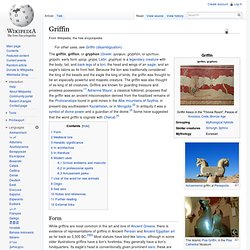
Because the lion was traditionally considered the king of the beasts and the eagle the king of birds, the griffin was thought to be an especially powerful and majestic creature. The griffin was also thought of as king of all creatures. Form While griffins are most common in the art and lore of Ancient Greece, there is evidence of representations of griffins in Ancient Persian and Ancient Egyptian art as far back as 3,300 BC.[5][6] Most statues have bird-like talons, although in some older illustrations griffins have a lion's forelimbs; they generally have a lion's hindquarters.
Lamassu. Lamassu at the British Museum.

A lamassu (Cuneiform: 𒀭𒆗, AN.KAL; Sumerian: dlamma; Akkadian: lamassu) is an Assyrian protective deity, often depicted with a bull or lion's body, eagle's wings, and human's head.[1] In some writings, it is portrayed to represent a female deity.[2][3] A less frequently used name is shedu (Cuneiform: 𒀭𒆘, AN.KAL×BAD; Sumerian: dalad; Akkadian, šēdu; Hebrew: שד) which refers to the male counterpart of a lamassu.[4] See the etymology section for a full explanation of the relationship of the names. Iconography[edit] In art, lamassu were depicted as hybrids, either winged bulls or lions with the head of a human male. Maltese tiger. An artist’s rendering of a Maltese tiger, with the grey hue characteristic of other "blue" felines The term "Maltese" comes from domestic cat terminology for blue fur, and refers to the slate grey coloration.
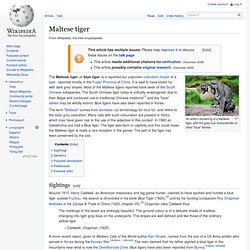
Many cats with such colouration are present in Malta, which may have given rise to the use of the adjective in this context. In 1960 an Oaklahoma zoo had a Blue tiger. Manticore. The manticore (Early Middle Persian Martyaxwar) is a Persian legendary creature similar to the Egyptian sphinx. It has the body of a red lion, a human head with three rows of sharp teeth (like a shark), sometimes bat wings, and a trumpet-like voice. Other aspects of the creature vary from story to story. It may be horned, winged, or both. The tail is that of either a dragon or a scorpion, and it may shoot poisonous spines to either paralyze or kill its victims. Narasimha. Narasimha (Sanskrit: नरसिंह; Narasiṃha), (Tamil: நரசிம்மர்), (Kannada:ನರಸಿಂಹ) Narasingh, Narsingh and Narasingha-in derviative languages is an avatar of the Hindu god Vishnu and one of Hinduism's most popular deities, as evidenced in early epics, iconography, and temple and festival worship for over a millennium.[1] Narasimha is often visualised as half-man/half-lion, having a human-like torso and lower body, with a lion-like face and claws.[2] This image is widely worshipped in deity form by a significant number of Vaishnava groups.
He is known primarily as the 'Great Protector' who specifically defends and protects his devotees in times of need.[3] Scriptural sources[edit] References from Vedas[edit] The Rig Veda contains an epithet that has been attributed to Narasimha. Narasimha and Prahlad[edit] Bhagavata Puran describes that in his previous avatar as Varaha, Vishnu killed the asura Hiranyaksha. Prahlad then answers, He was, He is and He will be. Narasimha and Adi Shankara[edit] Others: Nekomata. Nekomata (original form: 猫また, later forms: 猫又, 猫股, 猫胯) are a yōkai of cats told about in folklore as well as classical kaidan, essays, etc. There are two very different types, the beast that lives in the mountains, and the ones raised domestically that grow old and transform.[1] Nekomata in mountains[edit] "Nekomata to Ifu Koto (ねこまたといふ事?) " Nemean lion. The Nemean[pronunciation?] Lion (Greek: Λέων τῆς Νεμέας (Léōn tēs Neméas); Latin: Leo Nemaeus) was a vicious monster in Greek mythology that lived at Nemea.
It was eventually killed by Heracles. It could not be killed with mortals' weapons because its golden fur was impervious to attack. Its claws were sharper than mortals' swords and could cut through any armor. Panther (legendary creature) Ancient Greek art depicting Dionysus riding a panther A Panther is a creature out of ancient myth that resembles a big cat with a multicoloured hide.
Phantom cat. Phantom cats, also known as Alien Big Cats (ABCs) - large felines, such as jaguars, cougars, and panthers - allegedly appear in regions outside their indigenous range. Sekhmet. Sphinx. Surrey Puma. Underwater panther. White Tiger (China)